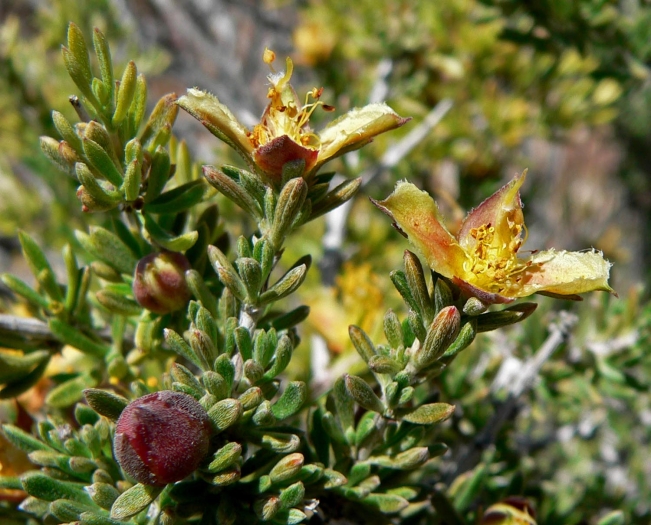Blackbrush
(Coleogyne ramosissima)
Blackbrush (Coleogyne ramosissima)
/
/

Stan Shebs
CC BY-SA 3.0
Image By:
Stan Shebs
Recorded By:
Copyright:
CC BY-SA 3.0
Copyright Notice:
Photo by: Stan Shebs | License Type: CC BY-SA 3.0 | License URL: https://creativecommons.org/licenses/by-sa/3.0 | Uploader: Stan Shebs | Publisher: Wikimedia Commons | Title: Coleogyne_ramosissima_4.jpg | Notes: Transferred from en.wikipedia |

































































Estimated Native Range
Summary
Coleogyne ramosissima, commonly known as Blackbrush, is an evergreen shrub native to arid deserts and scrublands of the Southwestern USA, particularly the Mojave, Great Basin, and Sonoran deserts. It typically grows to a height of 2-5 feet and a width of 0.5-2 feet, forming dense thickets that can spread across the ground or grow erect. Blackbrush is well-adapted to its harsh native environment, with gray branches that darken when wet, earning its common name. The plant is drought-deciduous, dropping most of its leaves during severe dryness while retaining some at the end of the branches to endure extreme conditions.
Blackbrush produces small, yellow, leathery flowers from April to July, following significant spring rainfall. The flowers, which grow at the ends of short stems, are not particularly showy but are ecologically significant for desert pollinators. In cultivation, Blackbrush is valued for its resilience and low water requirements, making it suitable for xeriscaping and naturalistic plantings in arid regions. It thrives in full sun to part shade and prefers well-drained soils. While it is not commonly used in ornamental horticulture, it can serve as an effective ground cover or erosion control plant in suitable climates. Care should be taken as it may become dormant or die back in excessively wet conditions.CC BY-SA 4.0
Blackbrush produces small, yellow, leathery flowers from April to July, following significant spring rainfall. The flowers, which grow at the ends of short stems, are not particularly showy but are ecologically significant for desert pollinators. In cultivation, Blackbrush is valued for its resilience and low water requirements, making it suitable for xeriscaping and naturalistic plantings in arid regions. It thrives in full sun to part shade and prefers well-drained soils. While it is not commonly used in ornamental horticulture, it can serve as an effective ground cover or erosion control plant in suitable climates. Care should be taken as it may become dormant or die back in excessively wet conditions.CC BY-SA 4.0
Plant Description
- Plant Type: Shrub
- Height: 1.5-4.5 feet
- Width: 0.5-1.5 feet
- Growth Rate: Slow
- Flower Color: Yellow
- Flowering Season: Spring
- Leaf Retention: Evergreen
Growth Requirements
- Sun: Part Shade, Full Sun
- Water: Low
- Drainage: Fast, Medium
Common Uses
Drought Tolerant, Erosion Control, Low Maintenance
Natural Habitat
Native to arid deserts and scrublands of the Southwestern USA, particularly the Mojave, Great Basin, and Sonoran deserts
Other Names
Common Names:
Scientific Names: , Coleogyne ramosissima,
GBIF Accepted Name: Coleogyne ramosissima Torr.